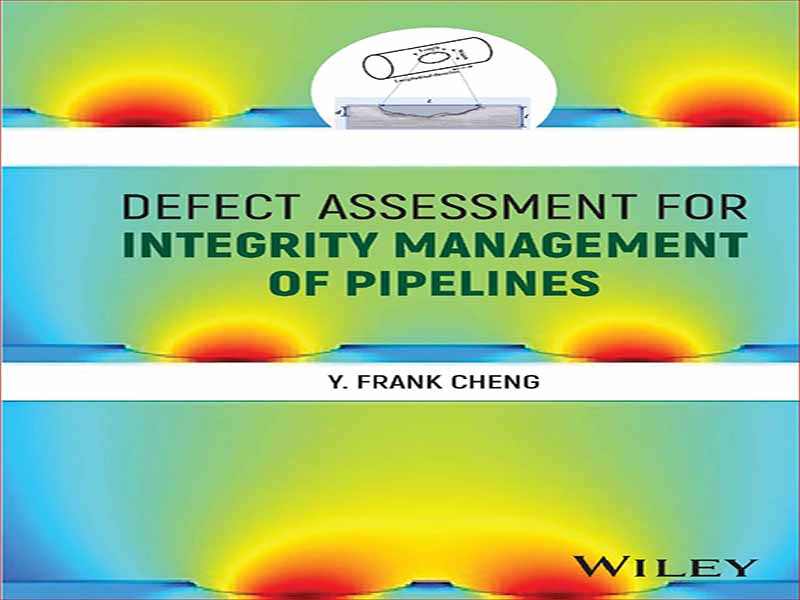- عنوان کتاب: Defect Assessment for Integrity Management of Pipelines
- نویسنده: Y. Frank Cheng
- حوزه: مدیریت خط لوله
- سال انتشار: 2024
- تعداد صفحه: 355
- زبان اصلی: انگلیسی
- نوع فایل: pdf
- حجم فایل: 31.1 مگابایت
ارزیابی نقص یک جزء ضروری است که در برنامه مدیریت یکپارچگی خطوط لوله ضروری است. ارزیابی نقص با پردازش و تجزیه و تحلیل دادههای جمعآوریشده توسط ابزارهای بازرسی درون خطی (ILI) و از منابع دیگر مانند سوابق تاریخی، سیستم کنترل و نظارت عملیاتی و بازرسیهای آفلاین/فراز زمینی با مدلها، فرمولها و الگوریزمهای عددی مختلف، اطلاعاتی را ارائه میکند. در مورد وضعیت عملکرد خطوط لوله، از جمله پیشبینی فشار شکست، تعیین تناسب برای سرویس (FFS)، و بیشتر، تخمین عمر سرویس باقیمانده. ارزیابی نقص همچنین به ارزیابی ریسک شکست و قابلیت اطمینان و توصیههای اقدامات و اقدامات مناسب برای کاهش و کنترل شکست خط لوله کمک میکند. تکنیک ارزیابی نقص خط لوله در چندین دهه گذشته تکامل یافته است و توسعه سه سطح پیشرفت فنی را تجربه کرده است، یعنی روشهای سطوح I، II و III. با هدف تعیین توزیع تنش و کرنش در عیوب و ارزیابی FFS خط لوله و فشار شکست، سه سطح از روش ها خود را عمدتاً با دقت بهبود یافته اندازه نقص، گنجاندن برهمکنش چند عیوب و حل مسائل بسیار غیرخطی در آن متمایز می کنند. ارزیابی نقص در خطوط لوله، به ترتیب. امروزه روش های سطوح I و II به طور گسترده در صنعت برای بهبود مدیریت یکپارچگی مورد استفاده قرار گرفته اند، در حالی که روش سطح III که بر مدل سازی و تحلیل اجزا محدود (FE) برای حل غیرخطی بودن در عیوب خط لوله متکی است، کاربردهای خود را عمدتاً در تحقیقات مهندسی پیدا کرده است. جامعه به دلیل نیاز به دانش پیش زمینه و پیچیدگی محاسباتی. در دهه گذشته، گروه تحقیقاتی من بر ارزیابی نقص سطح III در خطوط لوله، توسعه مدلها و روشهای مختلف مبتنی بر FE برای تعیین توزیع تنش و کرنش در عیوب خوردگی بر اساس تعریف دقیق ابعاد عیب در شرایط عملیاتی خط لوله، تمرکز کرده است. ارزیابی اثر آنها بر FFS خطوط لوله و پیشبینی فشار شکست. علاوه بر این، ارزیابی نه تنها یک نقص خوردگی منفرد در خطوط لوله را مورد هدف قرار میدهد، بلکه چندین نقص را نیز هدف قرار میدهد که ممکن است یک تعامل متقابل بین آنها برای تخریب بیشتر یکپارچگی خط لوله وجود داشته باشد. برای جهتگیریهای مختلف، عیوب خوردگی با یکدیگر همسو میشوند، فواصل بحرانی بین آنها برای تعیین وجود یک برهمکنش تعریف میشود، به طوری که باید با هم یا جداگانه ارزیابی شوند. سهم عمده گروه من در توسعه تکنیک ارزیابی نقص سطح III، بر اساس مفهوم نظری برهمکنش مکانیکی-الکتروشیمیایی است که در سال 2013 پیشنهاد کردم، برای ادغام نیروی مکانیکی با نیروی الکتروشیمیایی، توسعه یک مدل کوپلینگ میدان چند فیزیک برای نقص. ارزیابی با در نظر گرفتن ماهیت دینامیکی عیوب خوردگی در محیط های خدمات واقعی. قبل از آن، عیوب خوردگی معمولاً به عنوان ویژگی های از دست دادن فلز در نظر گرفته می شد، در حالی که روند پویای رشد عیب به دلیل واکنش های خوردگی نادیده گرفته می شد. این به عنوان تکنیک های ارزیابی نقص خط لوله “انقلابی” در نظر گرفته می شود. روش جدید ارزیابی نقص سطح III، در اولین بار در نوع خود، امکان پیشبینی نرخ رشد نقص خوردگی در خطوط لوله را تحت همافزایی نیروهای مکانیکی و الکتروشیمیایی، بازتولید واقعیت و در نتیجه ارائه نتایج دقیقتر و مطمئنتر فراهم میکند. علاوه بر عیوب خوردگی، روش ارزیابی سطح III یکپارچه تعامل مکانیکی-الکتروشیمیایی نیز کاربرد خود را به انواع دیگر ناهنجاریهای سطحی مانند فرورفتگی، سگک و چین و چروک و همچنین ترکیبی از انواع مختلف عیوب گسترش داده است. علاوه بر این، ارزیابی عیب در هر دو لوله مستقیم و زانویی خط لوله که در آن عیوب شرایط مکانیکی و خوردگی متفاوتی را تجربه میکنند، اعمال میشود. معیارها و روشهایی برای ارزیابی عملکرد خط لوله و پیشبینی شکست ترکیدگی ایجاد شدهاند. این کتاب با مروری بر برنامه مدیریت یکپارچگی خطوط لوله در فصل 1 شروع می شود که در آن اصل اساسی، اجزا و روش های اصلی و مسیر طراحی مدیریت یکپارچگی خطوط لوله معرفی می شود. تهدیدهای مختلف برای تخریب یکپارچگی خط لوله در این زمینه مورد بررسی قرار میگیرند و ابزارهای مشترک ILI برای تشخیص عیوب سطحی خلاصه میشوند. فصل 2 توسعه تاریخی تکنیک های ارزیابی نقص را معرفی می کند، در حالی که بر اصول، معیارها و کاربردهای روش های سطح I و II تمرکز می کند. برای تحلیل محدودیتهای دو سطح روش ارزیابی، اظهارنظرهای تفسیری ارائه شده است. در فصل 3، روش ارزیابی نقص سطح III مبتنی بر FE از نظر اصول، معیارها و کاربردها برای تعیین FFS خط لوله و پیشبینی فشار شکست به تفصیل بیان شده است.
Defect assessment is an essential component which is integral to the integrity management program of pipelines. By processing and analyzing the data collected by in-line inspection (ILI) tools and from other sources such as historical records, operating control and monitoring system, and offline/aboveground inspections with various models, formulas and numerical algorisms, the defect assessment provides information about performance condition of the pipelines, including prediction of failure pressure, determination of fitness-for-service (FFS), and further, estimation of the remaining service life. The defect assessment also contributes to failure risk and reliability evaluation, and recommendations of proper measures and actions for pipeline failure mitigation and control. The pipeline defect assessment technique has evolved in the past several decades, experiencing development of three levels of technical progress, i.e., Levels I, II, and III methods. Targeting determination of the stress and strain distributions at the defects and evaluation of pipeline FFS and failure pressure, the three levels of methods distinguish themselves mainly by improved accuracy of the defect sizing, inclusion of the interaction of multiple defects, and solving highly nonlinear problems in defect assessment on pipelines, respectively. Nowadays, Levels I and II methods have been extensively used in industry for improved integrity management, while the Level III method, which relies on finite element (FE) modeling and analysis for solving nonlinearity at pipeline defects, has found its applications mainly in engineering research community due to background knowledge requirement and computational complexity. In the last decade, my research group has been focusing on Level III defect assessment on pipelines, developing various FE-based models and methods to determine the stress and strain distributions at corrosion defects based on accurate definition of the defect dimension under pipeline operating conditions, evaluating their effect on FFS of the pipelines and predicting the failure pressure. Moreover, the assessment targets not only a single corrosion defect on pipelines, but also multiple defects between which a mutual interaction may exist to further degrade the pipeline integrity. For various orientations the corrosion defects are aligned with each other, critical spacings between them are defined to determine if an interaction exists so that they should be assessed either together or separately. The major contribution of my group to development of the Level III defect assessment technique is, based on the mechano-electrochemical interaction theoretical concept I proposed in 2013, to integrate the mechanical force with electrochemical force, developing a multi-physics field coupling model for defect assessment while considering the dynamic nature of corrosion defects in actual service environments. Prior to that, the corrosion defects have been usually treated as metal-loss features, while ignoring the dynamic process of defect growth due to corrosion reactions. This is regarded as “revolutionary” to pipeline defect assessment techniques. The novel Level III defect assessment method, at the first time of its kind, enables prediction of the rate of corrosion defect growth on pipelines under the synergism of mechanical and electrochemical forces, reproducing the reality and thus providing more accurate and reliable results. In addition to corrosion defects, the mechano-electrochemical interaction integrated Level III assessment method has also expanded its use to other types of surface anomalies such as dents, buckles and wrinkles, as well as combinations of different types of defects. Moreover, the defect assessment applies on both straight pipes and pipeline elbows where the defects experience different mechanical and corrosion conditions. Criteria and methods are developed to evaluate the pipeline performance and predict burst failure. The book starts with an overview of pipeline integrity management program in Chapter 1, where the basic principle, main components and methods, and design pathway of integrity management of pipelines are introduced. Various threats to degrade the pipeline integrity in the field are reviewed, and common ILI tools for detecting surface defects are summarized. Chapter 2 introduces the historical development of defect assessment techniques, while focusing on the principles, criteria, and applications of Levels I and II methods. Commentary remarks are given to analyze the limitations of the two levels of assessment method. In Chapter 3, the FE-based Level III defect assessment method is detailed in terms of the principles, criteria, and applications for pipeline FFS determination and failure pressure prediction.
این کتاب را میتوانید از لینک زیر بصورت رایگان دانلود کنید:
Download: Defect Assessment for Integrity Management of Pipelines




































نظرات کاربران